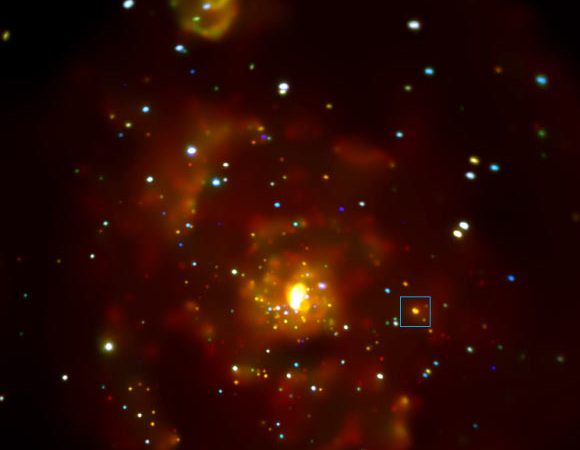Astronomers using NASA’s Chandra X-ray Observatory have detected an extragalactic candidate planet circling a binary system in Messier 51 (also known as M51, the Whirlpool Galaxy and NGC 5194), an interacting grand design spiral galaxy located some 26 million light-years away in the constellation of Canes Venatici.
Source: Sci News
“Planets are ubiquitous in the Milky Way. The conditions under which the known planets formed exist in other galaxies as well,” Dr. Rosanne Di Stefano from the Harvard & Smithsonian Center for Astrophysics and her colleagues wrote in their paper.
“Yet each external galaxy occupies such a small area of the sky that the high projected stellar density makes it difficult to study individual stars in enough detail to detect the signatures of planets through either radial velocity measurements or transit detection, the two methods responsible for the discovery of more than 4,300 exoplanets.”
“External galaxies host relatively small numbers — a handful to several hundred — of bright X-ray sources (XRSs),” they added.
“Luminous XRSs in external galaxies can be spatially resolved, and we can measure the count rate and X-ray emission from each source as a function of time.”
Using X-ray data from Chandra, the astronomers searched for possible planet transits in XRSs in three galaxies: Messier 51, Messier 101 and Messier 104.
They identified a single transit candidate in M51-ULS-1, one of the brightest XRSs known in Messier 51.
This X-ray source is between 100,000 and one million times brighter in X-ray emission than is the Sun at all wavelengths combined.
M51-ULS-1 is a massive binary system located at the edge of a young stellar cluster. One of its members is a compact object, either a neutron star or black hole, and the other is a massive star.
The newfound planet candidate, named M51-ULS-1b, produced a full, short-lived eclipse of the binary system.
“M51-ULS-1b is the first planet candidate discovered when it passed in front of an XRS whose size is comparable to its own,” the researchers wrote.
“It completely blocked the X-rays from M51-ULS-1 for a time interval of 20-30 minutes, with the excursion from baseline lasting roughly 3 hours.”
“There were no simultaneous observations in the optical or infrared, but the regions emitting at these longer wavelengths are so large in comparison with the XRS that there would likely not have been a detectable decline in emission.”
“This phenomenon is to be contrasted with planetary transits of stars, which produce relatively small dips in flux across wavebands.”
According to the authors, M51-ULS-1b is likely a gas-giant planet with a radius slightly smaller than that of Saturn.
“Our discovery of a single transit will lead to more detailed studies of planets and other low-radius objects in external galaxies,” they wrote.
“An equally thorough study of independent datasets will be important to develop better statistics. It is within the reach of the present generation of X-ray telescopes to develop information about the population of planets orbiting XRBs and for future generations of instruments to develop a comprehensive view.”
“The discovery of M51-ULS-1b has established that external galaxies host candidate planets,” they added.
“It also demonstrates that the study of X-ray transits can reveal the presence of otherwise invisible systems, which will also include brown dwarfs and low-mass stars.”
“Discovering and studying extragalactic planets and other small objects in external galaxies can establish connections and contrasts with the Sun’s environment in the Milky Way, provide insight into the mutual evolution of stellar and binary orbits, and expand the realm within which we can search for extraterrestrial life.”
“Extending the search will expand the scope of what we can say about our place in the Universe.”
The team’s paper will be published in the Monthly Notices of the Royal Astronomical Society Letters.
Source: Sci News

































Leave a Comment
You must be logged in to post a comment.